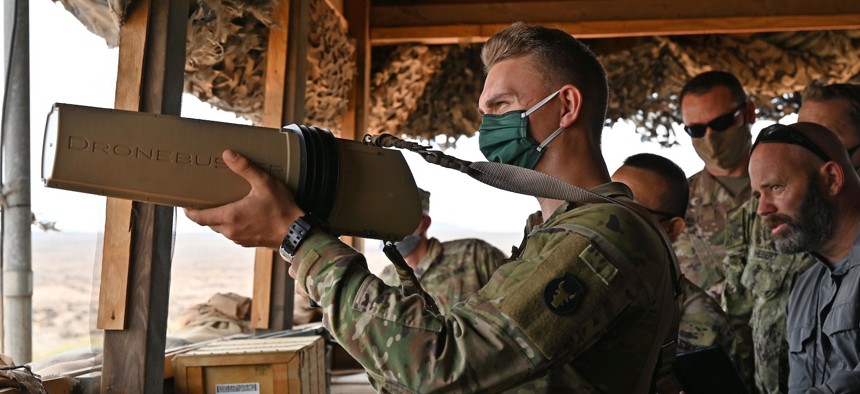
A soldier demonstrates the use of a Drone Buster for U.S. Army Maj. Gen. Lapthe C. Flora, commanding general of Combined Joint Task Force-Horn of Africa, during his visit to Chabelley Airfield, Djibouti, Oct. 31, 2020. U.S. Air Force / Tech. Sgt. Dana J. Cable
Army aims to equip a division with hand-held counter-drone gear
But one expert said the service may have underestimated just how much that will cost.
The Army’s 2025 budget request includes $13.5 million for hand-held anti-drone devices to equip a division and $54.2 million for backpack-size jammers, an Army spokesperson said Thursday.
The $13.5 million will buy 20 Modi devices, 10 Smart Shooter devices, 10 Bal Chatri devices, and 20 Dronebuster devices.
But equipping a division may require more, said Samuel Bendett of the Center for Naval Analysis, an expert on Ukraine and Russia’s use of drones in Ukraine.
“At the very least, each platoon should probably have [a hand-held anti-drone device], based on what we’re seeing in Ukraine so far,” he said.
The Modi and Dronebuster are both jamming systems, while the Bal Chatri detects the signals of potential enemy drones overhead. The Smartshooter, by contrast, is a rifle scope that calculates where to aim to take down fast moving drones.
The backpack jammers are the Terrestrial Layer System Manpacks, a system that provides both signals intelligence and jamming capabilities.
The Army previously said it was equipping two divisions with hand-held counter drone weapons: the 82nd Airborne and 1st Cavalry.
The 82nd Airborne and 1st Cavalry received the same types of hand-held counter-drone devices the Army requested for fiscal year 2025: the Modi, Smart Shooter, Bal Chatri, and Dronebuster. The 1st Cavalry trained 80 soldiers on the equipment, out of its force of 19,500. It is unclear how many sets the units received.
The Army also wants to beef up its air defense with larger counter-drone weapons, according to the fiscal year 2025 budget.
The service is seeking more jammers, including $82.5 million to buy the Mobile-Low, Slow, Small Unmanned Aircraft Integrated Defeat System (M-LIDS) and $26.4 million for the Fixed Site-Low, Slow, Small Unmanned Aircraft System Integrated Defeat System, or FS-LIDS.
The Army also asked for more money to buy systems that destroy drones outright, including $117 million for Coyote drone interceptors, and $88 million in research and development for the directed-energy variant of the Maneuver Short Range Air Defense (M-SHORAD) vehicle, $204 million for increment three of the M-SHORAD, and $22 million for increment one of the M-SHORAD.
As U.S. military bases in the Middle East face continuing drone attacks, Army leaders have praised Coyote interceptors as one of the most successful counter-drone systems. In January, the Army bought 600 Coyote 2C Interceptors for $75 million, at a cost of around $125,000 per interceptor.
Ukrainian troops use thousands of hand-held drone jammers and detectors, providing a much higher density of hand-held anti-drone devices than the U.S. Army currently fields. But the use reflects a battlefield reality—troops on both sides of the war use tens of thousands of drones each month for strikes and observation.
Even so, Russian first-person-view racing drones fitted with explosives regularly breach Ukrainian defenses, forcing Ukrainian troops to reduce their activity during the day to avoid being targeted.




